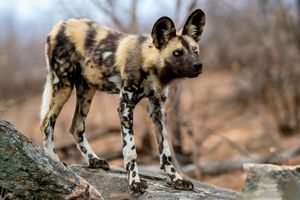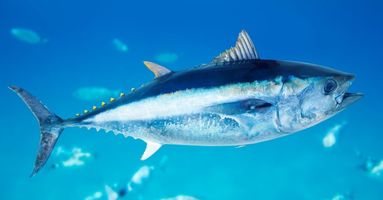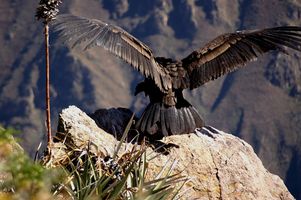

Endangered species
A list of threatened or endangered species can be found in this section. They are threatened by a variety of factors, some of which are caused by habitat deterioration, to which food waste can also contribute by generating methane, a greenhouse gas that causes climate change.
More than 44,000 species are threatened with extinction, according to the IUCN. This amount only accounts for about 28% of all species that have been evaluated. A few of these species, which are categorized as Vulnerable (VU), Endangered (EN), or Critically Endangered (CR), are the subject of our argument at +Green. The Worldwide Fund for Nature (WWF) provides a full explanation of these classification categories.

African Wild Dog
Critically Endangered
The African wild dog, also known as the African painted dog, is a colorful and highly social animal found in sub-Saharan Africa. It inhabits savannas, grasslands, and woodland areas. Unlike other canids, they have large rounded ears and a unique coat pattern of patches in various shades of brown, black, and white. African wild dogs live in packs and are excellent hunters, using cooperative tactics, such as pursuing their prey until it exhausts. They have a high success rate in capturing prey but face threats due to habitat loss and human-wildlife conflicts. With their complex social structure and energetic nature, African wild dogs exhibit enthusiastic greeting behaviors within their pack members and have a vocal communication system involving high-pitched vocalizations and unique chirping sounds.
Population (estimate): About 6600, of which 1,409 adults
Common threats: Accidental and targeted killings by humans, viral diseases like rabies and distemper, habitat loss and competition with larger predators like lions

Amur Leopard
Critically Endangered
The Amur leopard, also known as the Far Eastern leopard, is a critically endangered species native to the Russian Far East and northeastern China. It is one of the rarest big cats in the world, with an estimated population of less than 100 individuals in the wild. Amur leopards are known for their beautiful spotted coat, adapted for their forest habitat, and their ability to jump up to 10 feet vertically. Habitat loss, poaching, and climate change are the major threats to the survival of this majestic species. Conservation efforts are being made to protect and increase their population through initiatives such as habitat preservation and anti-poaching measures.
Population (estimate): About 84
Common threats: Poaching, habitat loss and degradation, prey depletion, and a number of consequential anthropogenic threats

Black Footed Ferret
Endangered
The black-footed ferret, also known as the American polecat, is a small mammal native to North America. They are known for their distinctive black markings on their feet, along with a white face mask and a slender body. Black-footed ferrets are highly endangered, with a population that was once on the brink of extinction due to habitat loss and the decline of their main prey, prairie dogs. Efforts to reintroduce and conserve these ferrets have been successful in recent years, but they still face ongoing threats to their survival.
Population (estimate): About 370
Common threats: Habitat loss and non-native disease

Bluefin Tuna
Endangered
Bluefin tuna are a highly sought-after and valued fish species that are known for their large size and strong swimming abilities. They can reach lengths of up to 10 feet and weigh over 1,000 pounds. Bluefin tuna are migratory fish that inhabit both the Atlantic and Pacific oceans. They are known for their high-quality meat, particularly prized for sushi and sashimi. However, overfishing and environmental factors have led to a decline in bluefin tuna populations, making them increasingly vulnerable and pushing for conservation efforts.
Population (estimate): Unknown
Common threats: Overfishing and illegal fishing

Bonobo
Endangered
Bonobos are one of the closest relatives to humans, sharing approximately 98.7% of our DNA. They are a species of great apes found only in the Democratic Republic of Congo. Bonobos are known for their peaceful and egalitarian social structure, where females play a prominent role in the society. They are highly intelligent and exhibit complex social behaviors such as problem-solving, empathy, and sharing. Additionally, bonobos are sexually promiscuous and use sexual activity as a means of conflict resolution. Unfortunately, bonobos are classified as endangered due to habitat destruction and illegal hunting.
Population (estimate): 10,000 - 50,000
Common threats: Habitat loss and hunting

California Condor
Critically Endangered
The California condor is a critically endangered species of vulture found in North America. It has a wingspan of up to 9.8 feet, making it one of the largest flying birds in the world. The condor primarily feeds on carrion and nests in remote areas such as cliffs and caves. Conservation efforts, including captive breeding programs, have helped to increase the population of California condors, but they still face various threats such as habitat loss and lead poisoning from scavenging contaminated carcasses.
Population (estimate): About 561
Common threats: Lead poisoning, predation

Elephant
Multiple
The California condor is a critically endangered species of vulture found in North America. It has a wingspan of up to 9.8 feet, making it one of the largest flying birds in the world. The condor primarily feeds on carrion and nests in remote areas such as cliffs and caves. Conservation efforts, including captive breeding programs, have helped to increase the population of California condors, but they still face various threats such as habitat loss and lead poisoning from scavenging contaminated carcasses.

Giant Panda
Endangered
Giant pandas primarily live in the mountainous regions of central China. They are one of the world's most endangered species, with an estimated population of around 1,800 individuals in the wild. Their main threats include habitat loss due to deforestation, fragmentation, and human encroachment, as well as low reproduction rates and resource limitations as they are specialized feeders that mainly eat bamboo. Conservation efforts have been made to protect their habitats and promote breeding programs to ensure their survival.
Population (estimate): About 1,864 in the wild
Common threats: Habitat loss, climate change.

Gorilla
Multiple
Gorillas primarily live in the forests of central and eastern Africa. There are estimated to be around 100,000 gorillas left in the wild, making them critically endangered. This is mainly due to habitat loss, poaching, and disease outbreaks like the Ebola virus. Conservation efforts are crucial to protect gorillas and their fragile ecosystems.

Humphead Wrasse
Endangered
The Humphead wrasse, also known as the Napoleon wrasse, is a large and distinct fish found in the Indo-Pacific region. It is known for its unique hump on its head, which gives it its name. This species plays an important role in coral reef ecosystems, as it is a top predator and helps maintain ecosystem balance. However, it is also highly vulnerable to overfishing and habitat degradation, making conservation efforts crucial to its survival.
Population (estimate): Unkown
Common threats: Live reef food fish trade, spearfishing, destructive fishing techniques (cyanide/dynamite), habitat loss and degradation, marine aquarium trade, and unregulated fisheries

Kakapo
Vulnerable
The kakapo is a critically endangered species of parrot native to New Zealand. It is known for its unique appearance, as it is the world's only flightless parrot, as well as its long lifespan and nocturnal behavior. Efforts are being made to protect and increase the population of kakapos through conservation and breeding programs.
Population (estimate): About 247
Common threats: Habitat loss and hunting

Monarch Butterfly
Endangered
Monarch butterflies are known for their vibrant orange and black wings. They can be found in North and South America, particularly in areas with milkweed plants, which serve as their main food source. The population of Monarch butterflies has been declining in recent years, with estimates suggesting a decrease of nearly 90% compared to previous decades. This decline is mainly due to habitat loss, deforestation, climate change, and the use of herbicides that kill milkweed plants. The loss of milkweed plants disrupts their life cycle, as Monarchs rely on them for reproduction and migration. Efforts are being made to conserve their habitats and increase their numbers.
Population (estimate): Unkown
Common threats: Deforestation, climate change, pesticides

Orangutan
Multiple
Orangutans are primarily found in the rainforests of Borneo and Sumatra in Southeast Asia. Current estimates suggest that there are around 104,700 Bornean orangutans and 7,500 Sumatran orangutans remaining in the wild. They are classified as critically endangered due to deforestation, habitat loss, illegal hunting, and the expansion of palm oil plantations, which are major threats to their survival. Conservation efforts are crucial to protect these intelligent apes and their habitats.

Pangolin
Critically Endangered
Pangolins are unique mammals that live in Asia and Africa, with eight different species existing today. They are critically endangered, with estimates suggesting as few as 100,000 remaining in the wild due to factors such as habitat loss and illegal hunting. Their scarcity is primarily fueled by the high demand for their scales and meat in traditional medicine and the illegal wildlife trade. Efforts are being made to protect and conserve this fascinating species.
All eight pangolin species are protected under national and international laws, and two are listed as Critically Endangered on the IUCN Red List of Threatened Species

Polar Bear
Vulnerable
Polar bears primarily live in the Arctic across the northernmost regions of Canada, Greenland, Russia, and parts of Alaska. As of 2020, their estimated population is around 20,000 to 25,000 individuals. They are considered endangered due to climate change and the subsequent loss of sea ice, which affects their ability to hunt for their primary food source, seals. The melting ice also leads to increased human activities in their habitat, further threatening their survival. Consequently, conservation efforts are crucial to protect this iconic species.
Population (estimate): 22,000-31,000
Common threats: Climate change, pollution

Red Panda
Endangered
The red panda is a species of mammal native to the Himalayas and southwestern China. It is known for its distinctive reddish-brown fur, bushy tail, and adorable appearance. Despite its name, the red panda is not closely related to the giant panda but is actually more closely related to raccoons and skunks. It is primarily arboreal, spending most of its time in trees, and feeds mainly on bamboo, as well as fruits, insects, and eggs. Due to habitat loss and poaching, the red panda is listed as endangered, and conservation efforts are crucial for its survival.
Population (estimate): Less than 10,000
Common threats: Habitat loss and degradation, human interference and poaching

Rhinoceros
Multiple
Rhinoceroses are large herbivorous mammals primarily found in Africa and Asia. Currently, there are five existing species: white, black, Indian, Javan, and Sumatran. Their populations have drastically declined due to poaching for their horns and habitat loss. They are considered endangered due to the critical threat they face from illegal hunting and their slow reproductive rate. Conservation efforts are crucial to ensure their survival.

Saola
Payment, shipping, and returns
The Saola, also known as the "Asian unicorn," is a critically endangered species found in the Annamite Mountains of Vietnam and Laos. It is a unique and elusive animal with distinct features like long, straight horns and vibrant colors. Sadly, due to poaching and habitat loss, the Saola population has declined drastically, making its conservation a top priority. Efforts are being made to protect this extraordinary creature and ensure its long-term survival.
Population (estimate): 70 - 700
Common threats: Habitat loss and hunting
Image: © Global Wildlife Conservation / Flickr (Original)

Sea Lion
Endangered
A sea lion is a marine mammal that belongs to the group of pinnipeds, which also includes seals and walruses. They are known for their streamlined bodies, flippers, and ability to swim gracefully in the ocean. Sea lions are social animals, often found in large colonies or harems, and they are known for their playful behavior and loud barking sounds. They have a varied diet, feeding on a variety of fish and invertebrates, and are excellent swimmers, capable of diving to great depths in search of prey. Overall, sea lions are fascinating creatures that thrive in coastal regions around the world.
Population (estimate): Unkown
Common threats: Pollution, climate change, disease & bycatch

Sea turtle
Endangered
Sea turtles are marine reptiles that live in all oceans except the polar regions. However, they are predominantly found in tropical and subtropical waters. There are seven distinct species of sea turtles, with varying populations. Unfortunately, all sea turtle species are endangered due to multiple factors, including habitat destruction, climate change, pollution, fishing activities, and illegal trade. It is estimated that there are anywhere between tens of thousands to a few hundred thousand sea turtles left, depending on the species.
Population (estimate): Unkown
Common threats: Poaching, fishing practices (bycatch), pollution (plastic), global warming

Snow Leopard
Vulnerable
Snow leopards are found in the mountainous regions of Central Asia, including the Himalayas. It is estimated that there are around 4,000 to 6,000 snow leopards left in the wild. They are considered endangered due to various factors, including habitat loss, poaching for their fur and body parts, retaliatory killings by local communities, and climate change impacting their native high-altitude ecosystems. Conservation efforts are ongoing to protect and ensure the survival of these majestic and elusive big cats.
Population (estimate): Between 4,080 - 6,590
Common threats: Habitat loss, over hunting & retaliatory killings.

Tiger
Critically Endangered
Tigers live in various habitats such as forests, grasslands, and mangrove swamps across Asia. However, their populations have significantly declined due to habitat loss, poaching for their body parts used in traditional medicine, and illegal wildlife trade. Currently, there are estimated to be around 3,900 tigers left in the wild, making them an endangered species. Conservation efforts are crucial to protect their remaining habitats and combat illegal activities threatening their survival.
Population (estimate): 5,574
Common threats: Habitat loss, poaching & retaliatory killings.

Vaquita
Critically Endangered
The vaquita is a critically endangered species of porpoise, found only in the Gulf of California. With a population estimated to be less than 10 individuals, it is the most endangered marine mammal in the world. The main threats to its survival are illegal fishing practices, specifically gillnet fishing, which often accidentally captures and kills vaquitas. Conservation efforts are underway to protect and save this species from extinction.
Population (estimate): 10
Common threats: Fishery bycatch
Follow Us
(c) 2024 +Green, All rights reserved
